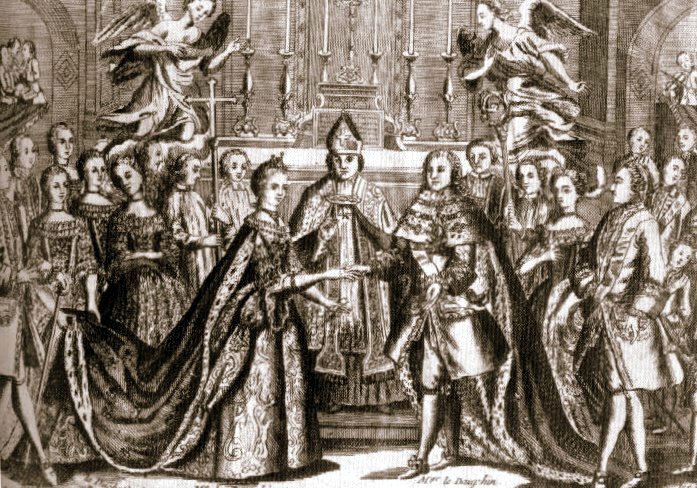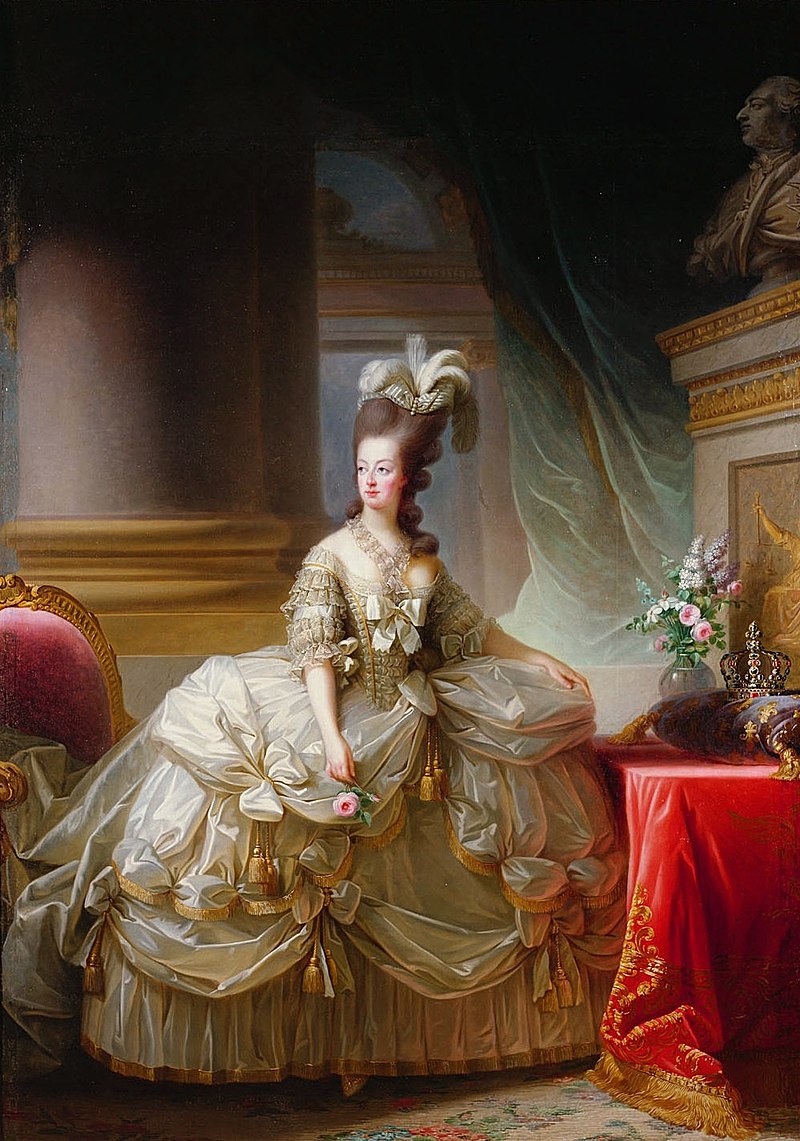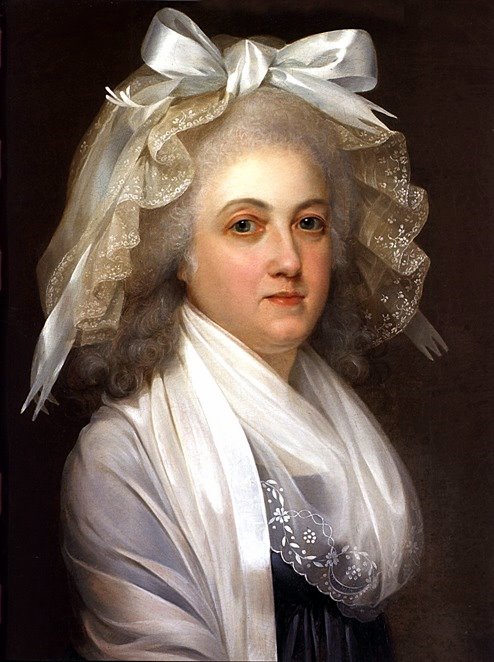by Scott Mehl © Unofficial Royalty 2016

Marie Antoinette, painted by Louise Élisabeth Vigée Le Brun, c1783. source: Wikipedia
Queen Marie Antoinette of France was born Archduchess Maria Antonia Josepha Johanna of Austria, Princess of Hungary and Bohemia, on November 2, 1755, at the Hofburg Palace in Vienna, Austria. Her parents were Maria Theresa, Archduchess of Austria, and Queen of Hungary, Croatia, and Bohemia in her own right and Francis Stephen, Duke of Lorraine, Grand Duke of Tuscany, Holy Roman Emperor Maria Antonia was the fifteenth of her parents’ sixteen children.
Maria Antonia’s siblings:
- Archduchess Maria Elisabeth (1737-1740), died in childhood
- Archduchess Maria Anna (1738-1789), died unmarried, no issue
- Archduchess Maria Carolina (1740-1741), died in childhood
- Holy Roman Emperor Joseph II (1741-1790), married 1) Isabel of Parma, married 2) Marie Josephe of Bavaria, had issue from his first marriage (two daughters, who died young)
- Archduchess Maria Christina (1742 – 1798), married Prince Albert of Saxony, Duke of Teschen, had one stillborn daughter
- Archduchess Maria Elisabeth (1743-1808), died unmarried, no issue
- Archduke Charles Joseph (1745-1761), died of smallpox, no issue
- Archduchess Maria Amalia (1746-1804), married Ferdinand, Duke of Parma, had issue
- Pietro Leopoldo I, Grand Duke of Tuscany, Leopold II, Holy Roman Emperor (1747-1792), married Infanta Maria Luisa of Spain, had issue
- Archduchess Maria Carolina (born and died 1748), died hours after baptism
- Archduchess Maria Johanna (1750-1762), died of smallpox, no issue
- Archduchess Maria Josepha (1751-1767), died of smallpox, no issue
- Archduchess Maria Carolina (1752-1814), married King Ferdinand IV of Naples and Sicily, had issue
- Archduke Ferdinand (1754-1806), married Maria Beatrice d’Este, had issue
- Archduke Maximilian Franz (1756–1801), became Archbishop-Elector of Cologne
Educated privately at home, Maria Antonia was not a very good student, especially compared to her siblings. However, she did become an accomplished musician, playing the flute, harp, and harpsichord. She was particularly close to her sister Maria Carolina who was just three years older.

The marriage of Marie Antoinette and Louis-Auguste, 1770. source: Wikipedia
After establishing peace with France, Empress Maria Theresa agreed to a marriage between Maria Antonia and Louis-Auguste, Dauphin of France (the future King Louis XVI). Maria Antonia was just 13 when the engagement was announced on June 13, 1769. The couple married by proxy on April 19, 1770, at the Augustinian Church in Vienna, Austria. She took the French version of her name, becoming Marie Antoinette, Dauphine of France. The following month, she arrived in her new country and met her husband for the first time. Two days later, on May 16, 1770, she and Louis-Auguste were married in a grand ceremony held in the Chapel Royal of the Palace of Versailles. They went on to have four children:
- Marie Thérèse Charlotte (1778 – 1851) – married her paternal first cousin Louis Antoine, Duke of Angoulême, no issue
- Louis Joseph Xavier François, Dauphin of France (1781 – 1789) – died in childhood
- Louis Charles, Duke of Normandy, Dauphin of France (1785 1795) – died in childhood, titular King Louis XVII of France
- Marie Sophie Hélène Béatrice (1786 – 1787) – died in infancy
As the new Dauphine of France, Marie Antoinette received a mixed reception. Well-liked by the common people, particularly due to her beauty and warm personality, she was distrusted by those who still held resentment over the country’s contentious relationship with Austria. Upon becoming Queen when King Louis XV in May 1774, she found that she had little influence on her husband, often finding her requests being blocked by two of his ministers. To appease her, King Louis XVI gave her the Petit Trianon on the grounds of the Palace of Versailles, built by King Louis XV as a home for his mistress Madame de Pompadour. However, she died before its completion, and it became the home of her successor Madame du Barry who had a tense relationship with Marie Antoinette. The chateau became Marie Antoinette’s retreat, where she could escape the immense pressure and judgment she faced in the French court.
Marie Antoinette also had a small hamlet built within the grounds of the Petit Trianon, known as the Queen’s Hamlet (Hameau de la reine). The hamlet contained numerous buildings, including the Queen’s House, a mill, a dairy, and a farm. It was here that the Queen truly found her privacy, allowing only her closest friends and family to visit her there.
Two years later, King Louis XVI purchased the Château de Saint-Cloud from Louis Phillipe I, Duke of Orleans for his wife. Marie Antoinette felt the clear air outside the city would be better for her children. As she had done with the Petit Trianon, Marie Antoinette transformed her new home, expanding the building and decorating it with lavish furniture commissioned specifically for the chateau.

Marie Antoinette in court dress, c1788. Painted by Louise Élisabeth Vigée Le Brun. source: Wikipedia
As Queen, Marie Antoinette was often criticized for her spending, indulging in lavish gowns and other luxuries while the country was in a financial crisis. This would contribute to a growing animosity from the French people and the “old guard” within the French court. She introduced new styles in clothing and hairstyles and indulged herself in music and theater. Over time, she began to exert more political influence, encouraging her husband to replace several of his older ministers, and prodding him to become involved in the American Revolution. Along with gaining the support of Russia and Austria in efforts to block Great Britain’s attack, she also pushed strongly for the appointment of several ministers who helped in the American defeat of the British.
By the mid-1780s, Marie Antoinette was the subject of endless gossip and character attacks from the French people. Rumors abounded that her second son was not fathered by her husband, that she was treating the French treasury as her own bank account, and that she held Austrian interests ahead of French interests. In 1785, she was falsely accused in the Diamond Necklace Affair, further damaging her reputation. Attempting to improve her image, she began to focus more publicly on the upbringing and education of her children, and spending more time in her public role and duties as Queen. However, the tides of revolution were soon to come to the shores of France. By 1789, the King had lost much of his absolute power to the National Assembly, and the majority of French people saw no benefit in retaining the monarchy.

Marie Antoinette facing the mob at the Tuileries Palace, June 1792. source: Wikipedia
After a failed attempt to escape Paris in 1791 ended what little support was left for the monarchy, the royal family was held under house arrest at the Tuileries Palace. On June 20, 1792, a mob broke into the Palace, threatening the Queen’s life. Spared this time, her luck would not be so good several months later when another mob stormed the palace on August 10, 1792. This time, the family sought refuge at the Legislative Assembly but were arrested several days later, and imprisoned at the Temple. On September 21, 1792, France officially abolished the monarchy and became a Republic. Marie Antoinette, her husband, and their family were stripped of their titles and honors, becoming known simply as Monsieur and Madame Capet.
King Louis XVI was soon separated from his family and charged with undermining the French Republic. He was tried, found guilty, and sentenced to death. The former King Louis XVI was executed by guillotine on January 21, 1793.

Marie Antoinette while a prisoner at The Temple, painted by Alexandre Kucharski c1792. source: Wikipedia
While held as a prisoner in the Temple, Marie Antoinette and her children were the cause of much debate, as the National Convention tried to determine what should be done with the former Queen. While some argued she should be put to death, others suggested holding her for ransom from the Holy Roman Empire, exchanging her for French prisoners of war, or exiling her to America. In July 1793, her son was taken from her, with the intent of turning him against his mother. Weeks later, on August 1, she was taken from the Temple and placed in a small cell in the Conciergerie. The once Queen of the French was now known as ‘Prisoner No. 280’.
On October 14, 1793, Marie Antoinette was tried by the Revolutionary Tribunal. Among other things, she was charged with organizing orgies at Versailles, sending millions in French treasury money to Austria, and planning the massacre of the National Guards. There were also charges of incest with her son. Two days later, she was found guilty of the main charges and sentenced to death.

Execution of Marie Antoinette, source: Wikipedia
Just after noon on October 16, 1793, Marie Antoinette was executed by guillotine in the Place de la Révolution (now the Place de la Concorde). She was buried in an unmarked grave in the Madeleine Cemetery. In 1815, her remains, along with those of her husband, were re-interred at the Basilica of Saint-Denis.
This article is the intellectual property of Unofficial Royalty and is NOT TO BE COPIED, EDITED, OR POSTED IN ANY FORM ON ANOTHER WEBSITE under any circumstances. It is permissible to use a link that directs to Unofficial Royalty.
France Resources at Unofficial Royalty
